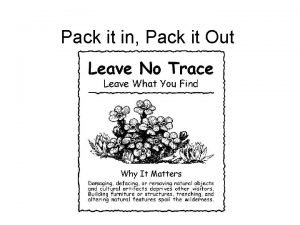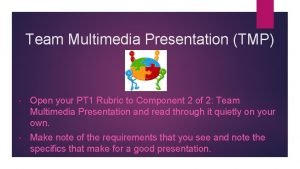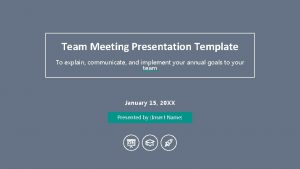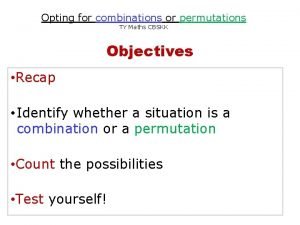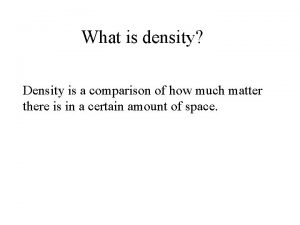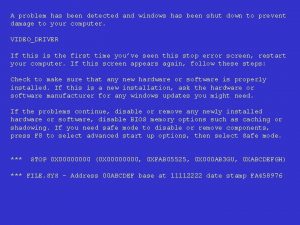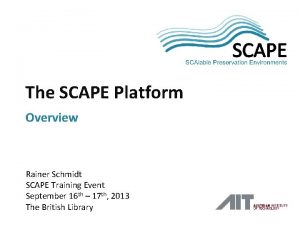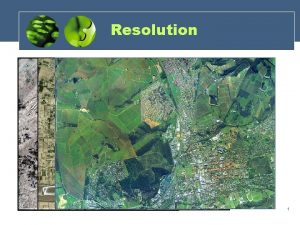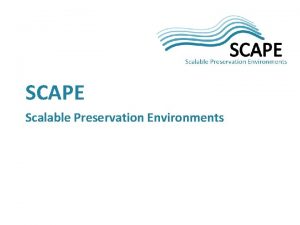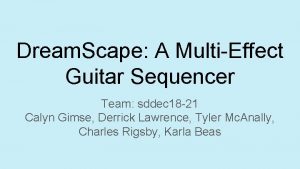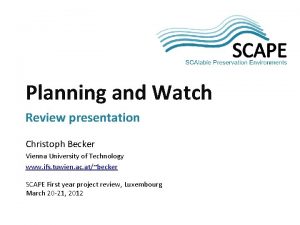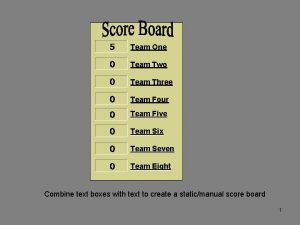Team Scape Express Presentation Pack This pack has


















- Slides: 18

Team. Scape Express Presentation Pack This pack has been designed to be used in Team development sessions lasting approximately 1. 5 -2 hrs Updated June 2013

Downloading the Chart Pack A new chart pack facility is now available in Facet 5. This feature allows you to download selected images from the Team. Scape report for use in a presentation. Please note at this time tables with values cannot be exported as an image. The following are downloadable in the Chart pack • Team Snapshot • Team Facet 5 Conflict Orientation • Team Overlay • Individual Work Cycle • Individual Facet 5 Conflict Orientation • Individual Facet 5 Conflict bars To download the chart pack: 1. From the Team. Scape window in the Facet 5 system, select your Team. Scape project 2. Under ‘Hard Copy’ in the right hand navigation select ‘Download Team. Scape Chart Pack’ 3. The folder containing the images will commence downloading. For Mac users refer to your download folder within Finder. The folder will have the same name as the project you selected. For PC users you will be prompted to select a location to save your folder. 4. Once downloaded the images will be available for use in this presentation 5. Refer to the instructions on updating images in this pack with the new images from the download chart pack

Updating Presentation Images This pack has been produced to assist practitioners facilitate teaming events using Team. Scape data. This pack makes us of master slide templates to hold the images for various slides that use the same image. This allows practitioners to update one slide To update images: 1. 2. 3. 4. The master slides will appear. 5. To update the image, right click on the centre of the image, select ‘change picture’. Browse to the location you stored your Chart pack, selecting the appropriate image for the slide. 6. The image should automatically resize to be the same size as the image holder 7. Repeat step 4 to update the images you require on other slide master templates 8. Select ‘Close Master’ to close the Master Slide view and return to the normal view. with the new image and it is then replicated on all slides where that image is used. Refer to the next page for an overview of the chart pack images and relevant slide templates. The notes page on each slide indicates if a master slide and chart pack image are used on that slide Ensure you have downloaded the chart pack from the Facet 5 Practitioner Workbench Select ‘View’ from the main horizontal menu, select ‘Master’ from the drop down list, then select ‘Slide Master’ Using the slide sorter pane select the master slide containing the image you wish to update. By hovering your mouse over the slide it will indicate the master slide template name. 9. Each slide should now contain the updated images 10. Save your file

Chart Pack Images Image: TeamFacet 5 Scores. gif Master slide template: Reaching Agreements layout Reaching Agreements overview Image: TeamTeam. Snap. Shot. gif Master slide template: Facet 5 Snap. Shot Layouts Image: TeamTeam. Overlay. gif Master slide template: Team. Overlay Overview Image: NameWorkcycle. gif Master slide template: Facet 5 Team. Overlay Layout

{Organisation Name} {Team Name} 6 July 2012 Facilitator: name Team Leader: name

Facet 5 Profile Team Member Overlay Will Energy Control Affection

Facet 5 Team Comparison by Factor: Will Low Will Do not jump to conclusions Wait to be asked Gives people a chance to speak Look at all the information Too slow to commit Procrastinate Defer to authority High Will Decide what needs to be done States own ideas clearly Defend ideas and don’t back down Appear certain and confident May try to push others Can start arguments Go own way without regard to others

Facet 5 Team Comparison by Factor: Energy Low Energy Thinks ideas through well Understands the depth Keeps discussion to a minimum Presents salient points Debates at a technical or specialist level Rarely discusses personal issues Prefer private research to open debate High Energy Gets started quickly Talk and discuss freely Shows obvious enthusiasm Are involved from the beginning Are easily distracted Interrupts others Loses focus and direction

Facet 5 Team Comparison by Factor: Affection Low Affection Gets to the point quickly Identify advantages early Find simple solutions Save time High Affection Don’t criticise others Are supportive of others Suggests alternatives Broadens the discussion Oversimplify issues Blind to broader impact Short term solutions Can wander off the point Do not promote ideas Avoid final decisions May be impractical

Facet 5 Team Comparison by Factor: Control Low Control Maintains a broad approach Encourage radical ideas Looks at the big picture Pushes the limits May not follow through May not persist if it gets too hard Can overlook important issues High Control Concentrates on the details Takes things steadily Organised Checks for resources and time available May be slow to get started May insist on too much detail Too conservative

Facet 5: Proportionality May be oblivious to importance of issues Can see blasé and unconcerned Under reacts to issues Becomes intense, Takes things seriously Takes things to heart Worries Gets things out of proportion

Facet 5 Team Snapshot This Snapshot shows how individuals within the team compare to each other in personal style. The closer you are to another person the more alike you will be in your personal style. Evaluation (Control) Implementation (Energy) Decision Making (Will) Generating Ideas (Affection)

Reaching Agreements, Solving Disputes Assertive (Will) This charts shows the orientation members of this team would be most likely to adopt if faced with conflict and disagreement. There are 5 main orientations, represented by the intersection of Will & Affection. Assertive people: Focus on their needs, desired outcomes and agenda Cooperative people: Focus on others needs and mutual relationships Cooperative (Affection)

Reaching Agreements, Solving Disputes Competing: High Will with Low Affection Typical Actions: • Let you know what they want • Argue their own case strongly • Focuses on their goals • Focuses on their needs • Argues to convince • Prepared to go it alone This style is useful when: • Quick decisive action is needed • Where unpopular courses of action need implementing • On vital issues when you know you’re right • To protect being taken advantage of Competing

Reaching Agreements, Solving Disputes Collaborating: High Will with High Affection Typical Actions: • Discusses issues directly • Shares the problem with others • Concerned to satisfy everybody’s wishes • Quickly tries to resolve differences • Seeks others help • Tells other own ideas and ask for others This style is useful when: • Concerns are too important to compromise • You want to learn from others • You need to see things from a different perspective • Gain commitment by involving others Collaborating

Reaching Agreements, Solving Disputes Accommodating: Low Will with High Affection Typical Actions: • Tries to preserve relationships • Will sacrifice their own wishes • Tries not to hurt feelings, keeping people happy • Tries to be considerate • Stresses those things where they agree This style is useful when: • When its more important to others than you • As a goodwill gesture • You want to collect credits for later issues • When preserving harmony is more important Accommodating

Reaching Agreements, Solving Disputes Avoiding: Low Will with Low Affection Typical Actions: • Seems to ignore differences of opinion • Avoids taking positions • Avoids arguments • Stays away from tension • Lets others take responsibility • Will defer an issue to gain time to think This style is useful when: • When an issue is trivial or others are more pressing • You want people to cool down and regain perspective • When more information is needed • When others can resolve it more effectively Avoiding

Reaching Agreements, Solving Disputes Compromising: Average Will and Affection Typical Actions: • Happy to give a little to get a little • Often proposes a middle ground • Tries to find a compromise • Looks for a fair balance • Prepared to trade-off This style is useful when: • Goals are not worth the disruption caused by being assertive • People of equal power are committed to mutually exclusive goals • You want to achieve temporary settlement • You need a quick expedient solution Compromising
 Scape procure
Scape procure Apa itu scape
Apa itu scape Pack it in pack it out
Pack it in pack it out Team spirit becomes team infatuation
Team spirit becomes team infatuation Team spirit becomes team infatuation
Team spirit becomes team infatuation The white team cheers for the blue team, just like
The white team cheers for the blue team, just like Team multimedia
Team multimedia Team meeting presentation template
Team meeting presentation template Team capability presentation
Team capability presentation Discrete math susanna epp
Discrete math susanna epp A basketball team has 12 members who can play any position
A basketball team has 12 members who can play any position Smallest anteroposterior diameter of the pelvic inlet
Smallest anteroposterior diameter of the pelvic inlet Cephalic presentation
Cephalic presentation Density of golden syrup g/cm3
Density of golden syrup g/cm3 A problem has been detected and windows o que é
A problem has been detected and windows o que é Problem has been detected and windows
Problem has been detected and windows The spring has sprung poem
The spring has sprung poem Every picture has a story and every story has a moment
Every picture has a story and every story has a moment Let him who has ears to hear
Let him who has ears to hear


